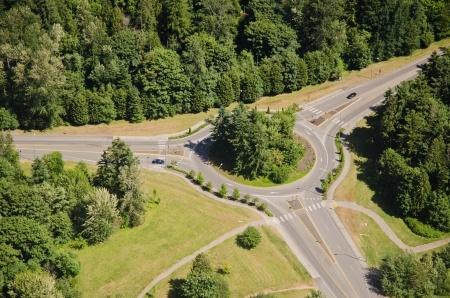Everyone hates roundabouts, but roundabouts are the safer, better intersection

A couple of years ago I was riding in a car with my husband and in-laws near LaConner, Washington, when we approached a roundabout. My father-in-law remarked grimly on the novelty, “Oh, uh oh,” and my mother-in-law added, “They’re dangerous!” My husband, who is a real riot at parties, said, “They’re actually considerably safer than 4-way intersections,” putting an end to everyone’s roundabout-bashing fun. But was my nerd husband correct? Yes. But does everyone hate roundabouts? Yes.
In neighborhoods across the country, traffic lights and 4-way stops are disappearing as roundabouts pop up in their place. Since 1990, over 3700 roundabouts have been constructed in the United States, and more are in the works every day. According to the Insurance Institute for Highway Safety (IIHS), there is on average a 40% decrease in all accidents and a 90% drop in fatal ones when a traffic intersection is replaced by a roundabout. And yet respondents in a 2011 NPR story refer to them affectionately as “blood circles.”
A cursory Google search reveals countless Letters to the Editor that implore local governments to rethink the madness that has led them to planning a roundabout, like this one that beseeches Knox County, Tennessee officials “This is an unconscionable waste of public funds. Cancel this ridiculous idea.” I wonder just how unconscionable it is to spend money on roundabouts when there are perfectly good traffic lights all over the place. While roundabouts are typically more expensive to install (thought this varies widely with the size and location of the intersection), they’re cheaper to maintain than signalized intersections, which require hardware and wiring and are more susceptible to damage. According to the Washington State Department of Transportation (WSDOT), yearly savings from roundabouts are estimated to be between $5,000 and $10,000 per year.
Another positive--roundabouts are better for the environment. Since traffic doesn’t come to a complete stop, idling vehicles aren’t constantly outputting pollution like they would when stopped for a long red light or even a stop sign. Of course, given the popularity of NASCAR and Hummers amongst Americans, this may not be a primary concern for the car-driving public. It may be a better argument to point out the individual cost-savings that accompany environmental considerations in addition to the taxpayer saving mentioned previously. Not only is there financial incentive, but your precious time is also saved by roundabouts. According to WSDOT, delays at an intersection can be reduced by 50 percent or more once a roundabout is installed, and fuel consumption can be reduced by up to 30 percent. When you consider how much of your life has been lost to long red lights, the numbers are compelling--no matter how much you love books on tape or exorbitant gas prices.
Sadly, all of these arguments in favor of roundabouts rely on facts, and if there’s one thing Americans prefer not to rely on, it’s facts. The best method for getting us to accept something is for the medicine to be shoved down our throats, then wait while we grudgingly accept that maybe we’re starting to feel better. With this in mind, let’s look at how we deal with roundabouts when we have no choice.
Generally, Americans resist and recoil whenever a roundabout is proposed or construction on one is announced. This resistance, however, seems to be attributed mostly to a lack of familiarity with how to use the intersection, and multiple studies indicate that people get over their initial terror/annoyance/get-off-my-lawn sensibilities. For example, in a 2002 study by the IIHS, three communities were surveyed where single-lane roundabouts replaced stop sign-controlled intersections. The institute found that 31 percent of drivers supported the roundabouts before construction, compared with 63 percent shortly after. Another study by the IIHS surveyed drivers in three additional communities where a one- or two-lane roundabout replaced stop signs or traffic signals. Overall, 36 percent of drivers supported the roundabouts before construction compared with 50 percent shortly after construction concluded, and follow-up surveys in these six communities after more than one year found the level of public support increased to about 70 percent on average.
So, my in-laws were probably suspicious of roundabouts because they’d almost never encountered them where they reside in rural central Wisconsin. Another factor that may be working against roundabouts is their perception as being foreign and fancy, two things that don’t appeal much to rugged American sensibilities. After all, France has over 32,000 of the things, and France thinks they’re so much better than us. Newsflash, France! You're not better than us! New idea: change “roundabout” to “freedom-go-round.”
Most of the above points to roundabouts being the province of the young. Young people like fancy things like the environment, and most of them are poor and therefore more moved by promises of extra gas money. I emailed my 25-year-old sister to ask what she thinks, and she responded, “Ummm, they're really great when people know how to use them? I think it's silly when people whine about them and try to make it seem like stop signs/lights are better.” An important thing to note about my sister, though, is that she has been to France, and she liked it.
What do you think? More importantly, what do your in-laws think? Are roundabouts chaotic wreaths of murder? Cost-saving, pollution-lowering saviors of motorists? A different type of intersection with a small learning curve that doesn't move you in any way? Not that it matters--you're getting one anyway!

Comments
round a bouts
Good points!
I've been surfing online more
I've been surfing online more than 3 hours today, yet I never found any interesting article like
yours. It is pretty worth enough for me. Personally,
if all website owners and bloggers made good content
as you did, the web will be a lot more useful than ever before.
Add new comment